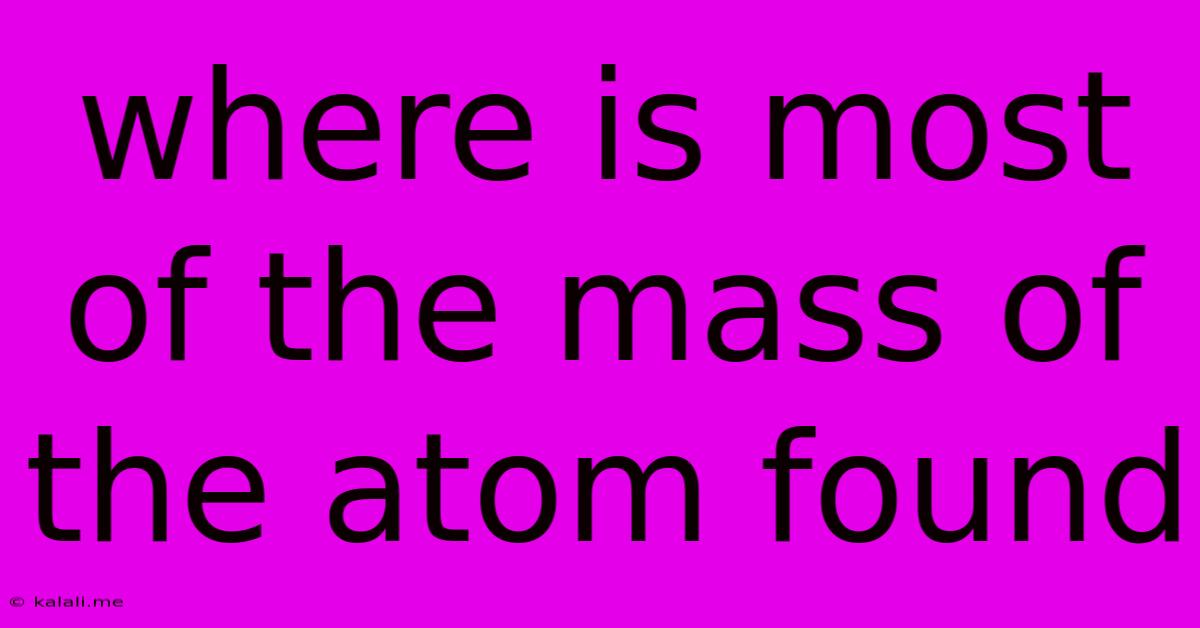Where Is Most Of The Mass Of The Atom Found
Kalali
Jun 13, 2025 · 2 min read

Table of Contents
Where Is Most of the Mass of an Atom Found? A Deep Dive into Atomic Structure
Have you ever wondered where the bulk of an atom's mass actually resides? It's a question that delves into the fascinating world of atomic structure and the fundamental building blocks of matter. This article explores the answer, revealing the surprising location of most of an atom's mass. Understanding this helps us appreciate the complexities of the incredibly tiny world within all matter.
Atoms are incredibly small, and their structure is often visualized as a miniature solar system. However, the reality is far more intricate and quantum mechanical in nature. We'll break down the components and where they contribute to the atom's overall mass.
The Components of an Atom: Protons, Neutrons, and Electrons
Atoms consist of three primary subatomic particles:
- Protons: Positively charged particles located in the atom's nucleus.
- Neutrons: Neutral particles (no charge) also found in the nucleus.
- Electrons: Negatively charged particles that orbit the nucleus in electron shells or energy levels.
Each of these particles contributes to the atom's overall properties, including its mass. However, their contributions differ significantly.
The Nucleus: The Heart of Atomic Mass
The majority of an atom's mass is concentrated in its nucleus. This tiny, dense region at the atom's center houses both protons and neutrons. Both protons and neutrons have roughly the same mass, significantly larger than that of electrons.
- Proton Mass: Approximately 1.67 x 10^-27 kg
- Neutron Mass: Approximately 1.67 x 10^-27 kg
- Electron Mass: Approximately 9.11 x 10^-31 kg
Notice the significant difference in mass between protons/neutrons and electrons. The electron mass is nearly 2000 times smaller than that of a proton or neutron.
The Negligible Contribution of Electrons
While electrons play a crucial role in determining an atom's chemical behavior and reactivity (via their involvement in chemical bonding), their contribution to the overall mass is practically negligible. The mass of the electrons in an atom is so small compared to the mass of the protons and neutrons that it can often be ignored in mass calculations.
In Summary: The Nucleus Holds the Key
Therefore, to answer the question directly: most of an atom's mass is found in its nucleus, specifically within the protons and neutrons. The electrons, while vital for chemical interactions, contribute almost nothing to the overall atomic mass. This concentration of mass in the tiny nucleus is a testament to the incredibly dense nature of this central part of the atom. Understanding this fundamental aspect of atomic structure is critical for grasping many concepts in chemistry and physics.
Latest Posts
Latest Posts
-
How Are Trade Offs And Opportunity Costs Related
Jun 14, 2025
-
What Does The Area Under The Velocity Time Graph Represent
Jun 14, 2025
-
Which Of The Following Is An Irrational Number
Jun 14, 2025
-
Which Of The Following Statements About Activity Based Costing Is True
Jun 14, 2025
-
Caring For A Client Who Has Paraplegia
Jun 14, 2025
Related Post
Thank you for visiting our website which covers about Where Is Most Of The Mass Of The Atom Found . We hope the information provided has been useful to you. Feel free to contact us if you have any questions or need further assistance. See you next time and don't miss to bookmark.